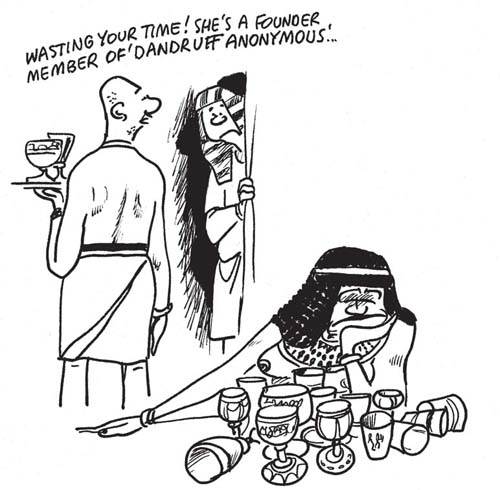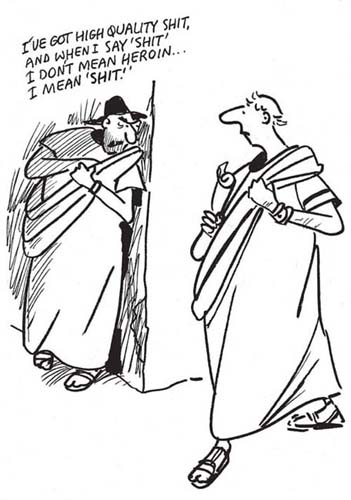Disgraceful Archaeology (12 page)
Read Disgraceful Archaeology Online
Authors: Paul Bahn

57

58
An Egyptian papyrus in the British Museum provides the recipe for a love potion to win a woman’s love: the man has to mix some dandruff from a murdered person’s scalp with some barley grains and apple pips, then add a little of his own blood and semen, and finally the blood of a tick from a black dog. This mixture, if slipped into the woman’s drink. should have devastating consequences (
58
). Another winning formula, designed to make a woman enjoy love-making, was to rub the foam from a stallion’s mouth into one’s member.
A Chinese manual on camel husbandry of the twelfth century says that if your camel suffers from violent wind, the remedy includes ‘powder of centipedes, beans soaked in wine, acupuncture behind the ears, and the letting of a great quantity of blood.’
Various formulas have come down to us from the Classical world for love philters, and cures for them, involving human excrement, perspiration, menses or semen. Human ordure, in particular, was in constant use in the manufacture of these philters, being administered both internally and externally. It was sometimes put in porridge, and in other cases in shoes — for example, a man who made such use of the excrement of his lady love was completely cured of his infatuation, after wearing the defiled shoes for one hour.
Pliny claimed that the urine that has been voided by a bull immediately after covering, taken as a drink, was an aphrodisiac; another was to rub the groin well with earth moistened with this urine. An ointment of the gall of goats, incense, goat-dung and nettle-seeds was applied to the privy parts before copulation, to increase the amorousness of women. And, according to Pliny, ‘They say that if a man takes a frog, transfixes it with a reed
entering its body at the sexual parts, and coming out at the mouth, and then dips the reed in the menstrual discharge of his wife, she will be sure to conceive an aversion for all paramours.’

59
Philters made with menstrual and a hare’s blood drove the recipient to mania and suicide, but could also be used to make people impenetrable to an enemy’s weapon and to cure burning sores.
Many believed that the ‘magnetic power’ of human seed could be used in philters, and that by it a lover could feed the flame of his mistress’s affections; it was prepared from what was known as
‘magnetic mummy’, which, being given to a woman, threw her into an inextinguishable frenzy of love for the man or animal yielding it.
Chinese emperors were required to keep 121 wives (the number was thought to have magical properties), and make love to 10 every night. A Taoist manual advised that this could be made possible by applying sheep’s eyelid marinaded in hot tea to the imperial penis (
59
).
Where anti-philtres are concerned, Pliny claimed that mouse-dung, applied in the form of a liniment, acts as an antiphrodisiac; and that a lizard, drowned in urine, has the effect of an antiphrodisiac upon the man whose urine it is. The same property is to be attributed to the excrement of snails and pigeon’s dung, taken with oil and wine. He also wrote that ‘a woman will forget her former love by taking a he-goat’s urine in drink.’ Hen-dung was an antidote against philtres, especially those made of menstrual blood; dove-dung was also used for the same purpose, but was less efficacious.
According to Paullini,’a man was given in his food some of the dried ordure of a woman he formerly loved, and that created a terrible antipathy toward her.’ Hardly surprising, surely?
But to break up a love affair, nothing was superior to the simple charm of placing some of the ordure of the person seeking to break away from love’s thrall in the shoe of the one still faithful, as described above — though Pliny also claimed that ‘If a man makes water upon a dog’s urine, he will become disinclined to copulation.’ Shoes could also be used in other ways — if a man, who under the influence of a philtre was forced to love a girl against his will, would put on a pair of new shoes, and wear them out by walking in them, and then drink wine out of the right shoe, where it could mingle with the perspiration already there, he would promptly be cured of his love, and hate take its place.
Roman magicians, according to Pliny, asserted that ‘the heart of a horned owl applied to the left breast of a woman, while asleep, will make her disclose all her secret thoughts.’

60
Pliny claimed that seminal fluid was a sovereign remedy for the sting of a scorpion. Male urine cured gout, and urine also cured eruptions on the bodies of infants, corrosive sores, running ulcers, chaps upon the body, stings inflicted by serpents, ulcers of the head, and cancerous sores of the generative organs .⦠Every person's urine is the best for his own case.
Pliny also gives a huge list of remedies involving the dung of different animals and birds (
60
). For example, badger-dung, cuckoo-dung and swallow-dung, taken internally, cure the bite of a mad dog; cat-dung, rubbed on the neck, removes bones from the throat; poultry-dung â but only the white part â is an excellent antidote to the poison of fungi and mushrooms; it is also a cure for flatulence and suffocations, which is bizarre since if any living creature only tastes this dung, it is immediately attacked with griping pains and flatulence. Ashes of mouse-dung, raven-dung and sparrow-dung were plugged into carious teeth, and used externally for all tooth troubles. Mouse-dung was good for imparting sweetness to sour breath, while pigeon-dung was used as a gargle for sore throats. Moose-dung, used externally, was good for swelled breasts. A dose of goat dung in the nappy could calm hyperactive children.
Dioskorides also had lots of tips involving dung â for instance, crocodile dung was in high repute as a cosmetic, though purchasers were warned that it was frequently adulterated with the excrement of starlings fed on rice.
Sextus Placitus, a fourth century AD author, claimed that the urine of a virgin boy or girl was an invaluable application for affections of the eyes; also for stings of bees, wasps and other insects. As a cure for elephantiasis, the urine of boys was to be drunk freely, while the crust from human urine was useful in burns and in bites of mad dogs.
Paracelsus, a sixteenth century alchemist, wrote:
the olde Physitians made very many medicines of most filthy things, as of the filth of the eares, sweat of the body, of women's menstrues, of the Dung of man and other beastes, spittle, urine, flies, mice, the ashes of an owle's head, etcâ¦â¦I call to mind a storieâ¦of Herachio Ephesio, which being sick of a leprosie, despising the help of Physitians, anoynting himself over with cow-dung, set himselfe in the sun to drie, and falling asleepe was torn to pieces by dogges (
61
).
Other remedies listed by Pliny involved ear-wax; woman's milk, especially of a woman who had just borne male twins (âif a person is rubbed at the same time with the milk of both mother
and daughter, he will be proof for all the rest of his life against all affections of the eyes; mixed with the urine of a youth who has not yet arrived at puberty, it removes ringing in the ears'); human sweat (if the perspiration of a fever-stricken patient was mixed with dough, baked into bread and given to a dog, the dog would catch the fever and the man recover); tartar (impurities from the teeth and the dirt from soiled stockings were a remedy for nose-bleed); and human blood â Faustina, the wife of the emperor Marcus Aurelius, was anxious to have a child, so she drank the warm blood of a dying gladiator, and then shared her husband's bed â she at once became pregnant and brought forth the cruel Commodus; epileptics would sometimes drink a draught of the warm blood caught gushing from the neck of a decapitated criminal.

61
Human flesh, from corpses, was administered under the name âMummy'; it was preferably from a malefactor, hanged on a gibbet, never buried, and the age should be between 25 and 40, of good constitution, without organic or other diseases, and gathered in clear weather.
In ancient Egypt, the use of contraceptives was known: one of the earliest methods, described in the Kahun papyrus, was to mix crocodile dung into a paste, which was made into a sort of tampon and inserted into the vagina. Another was to make a kind of tampon with honey, which is indeed a mild spermicide.
King Pyrrhos of Epiros had a big toe which was allegedly capable of curing diseases of the spleen when rubbed on the infected area. ⦠His toe did not burn when the rest of his body was cremated.
Sahagún gives details of the ancient Mexican formula for eradicating dandruff. It began by cutting the hair close to the root, and washing the head well with urine⦠Hippocrates recommended dove-dung, applied externally, in the treatment of baldness. Pliny claimed that the urine of the foal of an ass would thicken the hair, while camel dung, reduced to ashes and mixed with oil, would curl and frizzle the hair.
Human seed was often employed as medicine. Some credited it with a wonderful efficacy in relieving inveterate epilepsy, or restoring virility impaired by incantation or witchcraft; for which purpose it was used while still fresh, before exposure to the air, in pottage. The Albigensians or Cathars of medieval France are alleged to have sprinkled human semen on the eucharistic bread, possibly with the idea that the bread of life should be sprinkled with life-giving excretion.
Nature's Viagra: For impotence and loss of virility, Paullini recommends drinking the urine of a bull, immediately after he has covered a cow, and smearing the pubis with the bull's excrements; and also to piss through the engagement ring. Another cure for this infirmity was that the bridegroom should catch a fish, forcibly open its mouth, urinate into it, and then throw the fish back in the water, upstream; then try to copulate, taking care to urinate through the wedding ring, both before and after.
For sterility, Pliny recommends the application of a pessary made of the fresh excrement voided by an infant at the moment of its birth, while the urine of eunuchs was considered to be highly beneficial as a promoter of fruitfulness in females. Hawk-dung, drunk by a woman before coitus, insured conception; and goose or fox dung rubbed upon the pudenda of a woman aided in bringing about conception. But such remedies needed to be used with care â one woman applied the dung of a wolf to her private parts, and soon after bearing a child found him possessed of a wolfish appetite!
